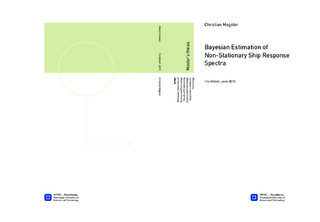| dc.description.abstract | The main topic of this master thesis is to obtain spectral information of non-stationary ship responses, with the motive of facilitating improvement of sea state estimation methods, that are using the wave buoy analogy. The wave buoy analogy is a method that uses the ship response to estimate the wave spectra. This method is restricted by constant operational conditions, such as vessel speed and direction, and is therefore limited to stationary processes. By introducing a method that can obtain spectral information from a time-varying ship response, the sea state estimation can be done without restrictions on the operational conditions. This can be achieved by the use of a parametric method, which is derived in this thesis.
The parametric method uses a time-varying auto-regressive model (TVAR) and Bayesian estimation methods to estimate the time-varying parameters, which can be transformed to the time-dependent power density spectrum of the ship response.
The algorithm is tested on stationary and non-stationary processes where key factors and limitations are identified. Simulation studies show that the performance of the algorithm is sensitive to the ratio between the co-variance of the state noise and the observation noise. The main limitation of the study is that this ratio needs to be tuned manually, and not in an adaptive way. In addition, the algorithm has a decreasing performance when the level of non-stationarity and the complexity of the spectrum increase.
The algorithm is tested on real data in a model test with Cybership III conducted in the MClab at NTNU. Unfortunately, the RAO s of Cybership were for different load conditions than those tested. Since the test study was approximately stationary, the algorithm could be compared with another using Fast Fourier Transform and smoothing functions. However, it was due to work with this thesis that the RAO s were found to be for a different load condition. Furthermore, it was found that the algorithm estimate a more narrow spectrum than the Fourier Transform method. | |

